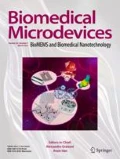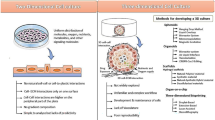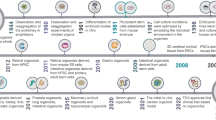Abstract
The quantitative studies of cell proliferation and migration under different chemical environments are important for both scientists and clinicians searching for new therapeutics. In this study, we developed a new device to pattern several types of cells in 24-well-plate and demonstrated its’ application in cancer cell proliferation and migration assay. The new device combined 3D-printed-silica-part for multi cell types loading with PDMS-through-hole-layer-part for cell micro-patterning which was matched with commercial 24-well-plate. This 24-well-plate based device is flexible and feasible in many applications and can be used in one piece or multi pieces. Besides the application for two types of cells proliferation and migration assay in one chemical condition, as a demonstration, the migration behaviors of four types of cells under 24 types of EGF + bFGF combinatorial conditions were studied. We believed this device could be widely used in clinical searching for new anti-cancer therapeutics and other related studies.




Similar content being viewed by others
References
S. Cosson, M.P. Lutolf, Hydrogel microfluidics for the patterning of pluripotent stem cells. Sci. Rep. 4, 4462 (2014)
P. Gheibi, K.J. Son, G. Stybayeva, A. Revzin, Harnessing endogenous signals from hepatocytes using a low volume multi-well plate. Integrative biology : quantitative biosciences from nano to macr 9, 427–435 (2017)
Y.Y. Jun, K.Y. Hye, N. Kyuhwan, M.S. Yun, H.O. Kyung, P.D. Kyeong, et al., Hydrogel-incorporating unit in a well: 3D cell culture for high-throughput analysis. Lab Chip 18, 2604–2613 (2018)
T.C. Kuo, C.T. Tan, Y.W. Chang, C.C. Hong, M.L. Kuo, Angiopoietin-like protein 1 suppresses slug to inhibit cancer cell motility. J. Clin. Invest. 123, 1082–1095 (2013)
A. Kwon, H.L. Lee, K.M. Woo, et al., SMURF1 plays a role in EGF-induced breast cancer cell migration and invasion[J]. Mol. Cells 36(6), 548–555 (2013)
T. Li, S. Jiang, Effect of bFGF on invasion of ovarian cancer cells through the regulation of Ets-1 and urokinase-type plasminogen activator[J]. Pharm. Biol. 48(2), 161–165 (2010)
Z.J. Li, Q.X. Cai, X.Q. Zhang, G.W. Si, Q. Ouyang, C.X. Luo, Y.H. Tu, Barrier crossing in Escherichia coli Chemotaxis. Phys. Rev. Lett. 118, 098101 (2017)
C.C. Liang, A.Y. Park, J.L. Guan, In vitro scratch assay: A convenient and inexpensive method for analysis of cell migration in vitro. Nat. Protoc. 2, 329–333 (2007)
N.V. Menon, Y.J. Chuah, S. Phey, Y. Zhang, Y. Wu, V. Chan, et al., Microfluidic assay to study the combinatorial impact of substrate properties on mesenchymal stem cell migration. ACS Appl. Mater. Interfaces 7, 17095–17103 (2015)
Q.H. Quan, S.W. Zhang, X.D. Wang, Q. Ouyang, Y.G. Wang, G. Yang, et al., A parallel and quantitative cell migration assay using a novel multi-well-based device. Biomed. Microdevices 18, 99 (2016)
K.I. Saito, T. Oku, N. Ata, H. Miyashiro, M. Hattori, I. Saiki, A modified and convenient method for assessing tumor cell invasion and migration and its application to screening for inhibitors. Biol. Pharm. Bull. 20, 345–348 (1997)
B. Shao, H.Y. Yuan, R. Zhang, X. Wang, S.W. Zhang, Q. Ouyang, et al., Reconstructing the regulatory circuit of cell fate determination in yeast mating response. PLoS Comput. Biol. 13, e1005671 (2017)
C.H. Stuelten, C.A. Parent, D.J. Montell, Cell motility in cancer invasion and metastasis: Insights from simple model organisms. Nat. Rev. Cancer 18, 296–312 (2018)
A. Valster, N.L. Tran, M. Nakada, M.E. Berens, A.Y. Chan, M. Symons, Cell migration and invasion assays. Methods 37, 208–215 (2005)
Y. Wang, X. Tang, X. Feng, C. Liu, P. Chen, D. Chen, et al., A microfluidic digital single-cell assay for the evaluation of anticancer drugs. Anal. Bioanal. Chem. 407, 1139–1148 (2015)
X. Yan, et al., bFGF promotes migration and induces cancer-associated fibroblasts differentiation of mouse bone mesenchymal stem cells to promote tumor growth. Stem Cells Dev. (2016). https://doi.org/10.1089/scd.2016.0217
W. Yang, Z.J. Li, W.L. Zhang, C.X. Luo, Q. Ouyang, G. Yang, Y.G. Wang, A novel density control device for the study of cancer cell autocrine effect. Biomed. Microdevices 15, 683–689 (2013)
Acknowledgments
We would like to thank Yugang Wang, Qi Ouyang, Feng Liu for helpful discussions. This study was supported by the NSFC of China (11974002, 11674010) and the National Key Research and Development Project (SQ2018YFA090070-03).
Author information
Authors and Affiliations
Corresponding authors
Additional information
Publisher’s note
Springer Nature remains neutral with regard to jurisdictional claims in published maps and institutional affiliations.
Jian Xu and Xudong Wang are co-first authors.
Rights and permissions
About this article
Cite this article
Xu, J., Wang, X., Li, X. et al. High-throughput cell migration assay under combinatorial chemical environments by a novel 24-well-plate based device. Biomed Microdevices 22, 40 (2020). https://doi.org/10.1007/s10544-020-00491-7
Published:
DOI: https://doi.org/10.1007/s10544-020-00491-7




